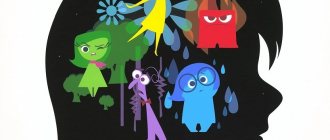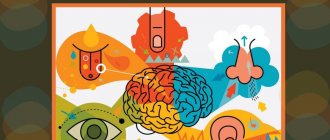Updated July 24, 2022 810 Author: Dmitry Petrov
Hello, dear readers of the KtoNaNovenkogo.ru blog. Today I want to talk about a very interesting thing - a person’s perception of the world around him and other people.
Let's take a look at this process from a psychological point of view to understand its essence. We will find out what properties it has, what types it is divided into, what errors sometimes arise and how a person perceives another person. I hope it will be interesting.
What is perception
Within different sciences, the formulation of this term differs. So, for example, in philosophy, perception is understood as a mental action, as a result of which clear images of objects in the surrounding world are formed in the human mind. At the same time, perception, by definition, is the result of a person receiving information about the surrounding reality, that is, it is a complete image of an object or phenomenon.
Important! Synonyms for perception are concepts such as “sensory cognition” and “perception”.
Content
- Physiological mechanism of perception
- Properties of perception
- Principles of perception
- Perception factors
- Effects of perception
- Classification of types of perception
- Perceptual disturbances Illusions of perception
- Hallucinations Eidetism as a type of hallucination
If we compare the definitions of two mental processes, i.e. perceptions and sensations, then you can notice some features. For example, perception is a more complex process. If sensations reflect individual properties of objects, then perception is a holistic reflection. Thus, the result of perception is a holistic perceptual image of an object, and not a separate property of it.
Signs of perception
Perception is a cognitive process in psychology, the result of which is the formation of a subjective picture of the world through the direct impact of an object or phenomenon on the human senses.
Personality orientation - what is it in psychology, its types
The completed image of an object in the human mind is formed as a result of the combined work of various analyzers. Thus, through vision one can draw a conclusion about the color of an object, and through tactile palpation one can obtain information about its texture. If you take an object in your hands, you can feel its weight, with the help of smell you can feel its smell, and through the receptors on the tongue you can determine the taste. It turns out that in the process of getting to know a subject, cognition and perception merge together.
Important! Perception is always subjective. Individual characteristics of the work of analyzers and a person’s life experience explain the fact that the finished image of an object perceived by different people may differ. The process of perception is inextricably linked with thinking, attention, memory, speech, and the emotional-volitional sphere.
Meaningfulness and generality
Homo sapiens perceives objects that have a certain content for him. Perception is closely connected with mental processes with awareness of the essence of the subject.
To consciously perceive a phenomenon means to mentally designate it, that is, to relate it to a certain class, to generalize it in a word.
Properties of human perception, such as generality and meaningfulness, allow the use of objects in an orderly manner. Knowing an object, people can accurately name it or say what it is similar to. Generalization of perception is the display of a particular case as a unique manifestation of the general.
The degree of generalization depends on the magnitude and completeness of existing knowledge. The generalization tool is represented by the word. Labeling objects increases the degree of generalization. The properties under consideration are well revealed when perceiving under-drawn images. People supplement such images with their own knowledge and experience.
When looking at an unknown object, people try to determine its similarity to other objects. Consequently, perception is not determined only by a set of stimuli, but is an eternal search for the optimal interpretation of available data.
Levels of perception
Mechanical memory - what is it in psychology and how is it characterized?
The process of forming a holistic image of an object goes through 4 levels:
- One of the analyzers notices the object. A person can see it, smell it or hear some characteristic sound.
- Correlating the signal from the analyzer with a particular object. This process occurs with reference to the existing in memory ideas about the objects of the surrounding reality and the correlation of the detected feature of the object with one or another standard.
- Identification and identification. As a result of mental activity, a person comes to the conclusion about what kind of object it is, what it is called, and what it is needed for. The result of the process is the formation of a complete image of the object.
Forming an image of an object
Types of perception in people
All analyzers always participate in the process of accepting the surrounding reality, but only 1 of them is the leading channel for obtaining information. So, when reading, the leading channel is vision, when listening to music – hearing, etc. Perception is usually classified on various grounds.
By modality
Adolescence crisis in psychology - what is it, reasons
According to modality, the following types of perception are distinguished:
- Visual – the formation of a complete image of an object in the mind;
- Auditory – the ability to perceive sounds;
- Tactile - obtaining information about a particular thing through touching it;
- Olfactory – the ability to distinguish odors;
- Gustatory – expresses the formation of ideas about food based on the work of taste buds.
Depending on the host analyzer
Depending on which analyzer is the leading one, perception is divided into simple and complex. Simple types include kinetic (based on sensations and movement), auditory (based on hearing) and visual (based on vision).
The main complex types and properties of perception are based on a combination of signals from different senses. If a person equally often relies on 2 or more analytical systems, this leads to the development of motor-visual-auditory or motor-visual perception.
Additional Information. In addition, there are special types of perception that appear in a specific situation during certain human actions. For example, when a person determines the distance to a destination, one type of perception is at work. When a man thinks about how a girl treats him, analyzing her behavioral reactions, another type of this mental process is activated.
How does she feel about me?
By update method
In psychology, such types of perception are distinguished as voluntary and involuntary. If this process is voluntary, then it has a specific goal, and the person takes specific actions to achieve it. Voluntary perception occurs when a person reads a scientific text with the desire to learn something new.
Involuntary perception is due to the bright characteristics of the object. It manifests itself, for example, when a late student enters the classroom - everyone present turns their heads at the sound of the door opening.
Constancy
This property presupposes the relative stability of the image of a phenomenon when the environment of perception changes. For example, regardless of the distance to the car, it will seem large to a person. Maximum constancy is manifested in visual cognition of the form, scale, and color of phenomena.
Constancy, revealed in the ability of the perception system to compensate for changes in the perceptual environment, ensures the knowledge of things surrounding the individual as conditionally unchangeable.
People repeatedly perceive certain phenomena, and such phenomena are perceived under completely different conditions. Without the constancy of perception, individuals would not be able to navigate the surrounding universe.
Basic properties of perception with examples
The mental process under consideration has the following properties:
- Integrity is a characteristic of the final image that arises as a result of a combination of sensations. The final image is always complete. For example, a fly is perceived by a frog as an object of hunting only when the fly moves. If the fly is motionless, the frog does not try to catch it, since it does not perceive it as an insect.
- Constancy - once acquired characteristics of a particular object, a person tends to correlate it with this particular object for a long time, accurately forming the final image. Minor changes in the characteristics of an item do not lead to difficulties with its classification. So, for example, a young man dates a tall girl who has blue eyes and blond hair. One day his girlfriend dyed her hair brunette. But he still perceives her as his partner; she has not become a stranger to him.
- Subjectness - the ability to combine an object with a generic group according to key characteristics. For example, green, round, sweet - this is an apple. Green, long, with paws and a tail - this is a crocodile. The process of classifying items into generic groups may take some time. Sometimes, for a correct correlation, a person needs to come up and take a closer look at the object or pick it up.
Objectivity of perception
- Structurality is reflected in the complexity of the perception process, which cannot be reduced simply to the sum of sensations from different senses. Replacing one of the key characteristics leads to the formation of a completely new image. So, for example, something large, iron and capable of floating is a ship. However, a large, iron one, capable of moving along railroad tracks is a train, not a ship.
- Selectivity – selection of 1 object from the background. The scope of perception is limited. A child cannot play with many toys at the same time. First of all, he will take the brightest or largest toy. This turns on selectivity: the baby chooses the most eye-catching object by color or size. Having chosen his favorite toy from a variety, the child loses interest in the others for a while; only the best one is in his field of perception.
- Apperception is the dependence of image formation on the individual characteristics of a person’s analytical systems and his life experience. The same object can be perceived differently by different people. So, for example, the Bible for believers is one of the main books of life, which sets out the rules of life and the foundations of society, but for an atheist it seems to be just a book that is no different from any other work of art.
- Perception activity is a person’s ability to be aware of the surrounding reality and accumulate experience in using objects. For example, initially the baby does not know what function the spoon performs. He can knock on the wall with it, look at it like in a mirror, dig sand with it. One day his mother shows him that he can eat with a spoon. Having learned this, the baby understands that a spoon is a cutlery, and not a hammer, a mirror or a spatula.
Theory of associative psychology
This theory was the first to be based on scientific observations, reaching its greatest influence in the second half of the 19th century. Representatives of this theory were German scientists I. Muller (1826), E. Mach (1865), G. Helmholtz (1867), E. Goering (1897), W. Wundt (1887), American psychologist E.B. Titchener (1898).
They believed that the image that a person perceives is a complex combination of the primary elements of consciousness - sensations. The sensation itself was understood as a conscious state of a sensory organ that was exposed to an isolated external stimulus.
The central problem for associative psychology was the problem of the perception of space, the difficulty of which lay in determining the primary sensations from which this perception is built and the methods of this unification.
Errors in Perception
As in any other mental process, errors occur in perception, as a result of which a person forms erroneous ideas about objects and phenomena. Typical perceptual errors include illusions and hallucinations.
Illusion
Illusion is a distorted perception of objects or phenomena. There are 2 types of illusions:
- Affectogenic illusions caused by emotions and feelings. For example, a timid person can clearly see a monster in the shadow of a bush, while a person with low self-esteem seems to be disliked by his superiors and is constantly being picked on.
- Pareidolic illusions, which are characterized by the appearance of fantastic images when interacting with reality. For example, black spots on a white sheet can be mistaken by a person for insects.
Hallucinations are a type of image that does not actually exist. Hallucinations are one of the symptoms of a mental disorder. So, a person can hear voices, he can imagine the presence of someone in the room, although at that moment in time there is no one next to him, and he is in silence.
Additional Information. A healthy person may experience hallucinations as a result of using psychotropic substances. Hallucinations can also be induced through hypnosis.
Integrity
A complete picture of an object is formed on the basis of summing up information about certain properties and characteristics of such an object obtained in the form of various sensations.
Collective sensations have such a strong relationship that a whole complex image of a phenomenon arises even with indirect influence on a person of only individual properties or individual elements of an object. This image appears relatively reflexively due to the connection between various sensations.
The integrity of perception consists in mentally bringing the received information to a complete representation of a certain phenomenon, even with a partial reflection of some properties of the cognizable phenomenon.
To obtain a holistic perception, the key factor is the experience of previous observations. So, for example, looking at a man standing sideways, that is, seeing only half of him, a person in his own perception receives a complete picture: a man with two upper limbs, two lower limbs, two ears. Therefore, when this man turns his face, the observer will see what he previously expected.
Hence, the perception of a particular individual is determined by his subjective picture of the universe and the image of individual objects of current existence. If the baby’s dad is tall and wears glasses, then the child’s prototype of the world reflects the relationship that lies in the conditioning of wearing glasses being tall. When meeting strangers with glasses in the future, the child will think that their height is slightly higher than in reality.
Person's perception by person
In social science, a peculiarity of people's perception of each other has been identified. When meeting someone, it is not possible to obtain enough information to form a complete, complete image. Only in the process of long-term communication do people get to know each other so much that a psychological portrait of a friend is formed in their minds.
At the time of the first meeting, people try to make a good impression if they are interested in a communication partner. They seem to stand on their tiptoes, wanting to become morally superior. At the very beginning of a relationship, people diligently disguise their shortcomings and weaknesses. A person’s primary image of an interlocutor is formed based on an analysis of his posture, posture, gestures, and communication style.
People's perceptions of each other
In addition, if the interlocutor reveals his profession, the person mentally attributes to him the stereotypical qualities of a typical representative of a particular field of professional activity. Thus, people tend to believe that teachers lead a correct lifestyle, and musicians are vulnerable, impressionable, and romantic.
A person’s social status also has a significant impact on the opinion others have about him.
Interesting fact. If a person has a beautiful appearance, then communication partners tend to endow him with positive personal qualities that he actually does not possess. If outwardly the interlocutor reminds a person of one of his relatives, sympathy for him arises from the first minutes of communication.
The illusion of reality
The illusion of perception occurs when reality is reflected distortedly, while the effect is sustainable. Illusions can occur in many people under the influence of physical, physiological and psychological reasons.
The breaking of a spoon in a glass of tea is classified as a physical illusion, and the splitting of the image when pressing sideways on the eyeball is considered a physiological illusion. A psychological illusion occurs when identical lines are overestimated up or down when their lengths are objectively equal.
Another example considers overvaluing the top parts of the figure. When dividing a vertical line in half, a person often makes the mistake of setting the middle much higher than the real one.
Development of perception in children
The foundations of perception as a mental process are laid in infancy. However, at an early age, the baby’s perception is still very imperfect. In the first years of life, a child develops visual-tactile and visual-motor connections that arise in the process of manipulative activities with objects. Later, the manipulation turns to “feeling” a new object with the gaze - this indicates a new stage in the development of perception.
In preschool and primary school age, perception is determined by the impressionability and emotionality of children: involuntary perception prevails over voluntary perception.
The most difficult for children to master are the spatial properties of objects that are associated with visual, kinesthetic and tactile sensations. During preschool childhood, children successfully master concepts such as shape, size and size of objects, learn to determine the distance and spatial arrangement of objects relative to each other.
The perception of time poses serious difficulties for children of primary preschool age. They do not always correctly use the words “tomorrow”, “yesterday”, “later”, “earlier”.
Children's perception of time
As the child masters the surrounding world, as well as systematic schooling, the child’s conditioned reflex connections improve, which is an impetus for the development of perception.
The key role in the development of children's perception belongs to adults. Thus, parents and teachers teach children how to operate with objects, guide the child’s development process, and draw his attention to the essential characteristics of objects and phenomena of reality. An adult’s detailed and complete answers to a child’s questions about certain objects and phenomena will mean a lot.
Attention! To develop a child’s perception, it is necessary to organize his play and practical activities with objects. During the game, children learn to distinguish the basic properties of objects: color, weight, shape, size. In order for a child to study an object and understand its purpose, he needs to touch it and try to perform various actions with it. During the game and practical activities, optimal conditions are created for the interaction of analyzers, which leads to the formation of a holistic view of the world.
Children's artistic activities have enormous potential for the development of perceptual skills. In drawing from a model and in the process of sculpting, children learn to feel proportions, convey the shape and size of an object, and distinguish between shades of a palette. Thus, by older preschool age, the child’s perception becomes controlled and arbitrary.
During the period of schooling, perception is improved due to the variety of academic disciplines and various types of activities of children under the guidance of a teacher. To develop perceptual skills, the teacher must use visual aids: firstly, this stimulates the work of several analyzers at once, and secondly, it contributes to better memorization of information. Independent search work of students is of great importance.
Thus, perception plays an important role in human life. Perceptual skills formed at a high level ensure successful learning, harmonious personal development, and the ability for scientific creativity. It is important for adults to remember that this ability will not be formed by itself; it is necessary to create conditions for the child to play with different objects from an early age. It is important in early childhood to give the opportunity to develop sensory standards and cognitive interest. If these conditions are met, during school the child will be active and independent in learning about the world around him.
Brief perception of reality
Apperception
The acquired experience of perception occupies a key position in the course of perception. The specifics of perception are determined by all the previous practical and everyday experience of the individual. Apperception refers to the conditioning of perception by past experience and the personal characteristics of the perceiver.
In order to classify, in the course of perceiving objects that he cognizes, a person puts forward and verifies various conclusions about the belonging of an object to a particular class of objects.
It is in this manner that past experience and knowledge are used in perception, so different individuals may perceive one phenomenon differently. The content of perception is determined by the task at hand, the basis of activity, and needs. A significant role in apperception is given to attitudes and emotional responses, which can easily modify the content of perception.








